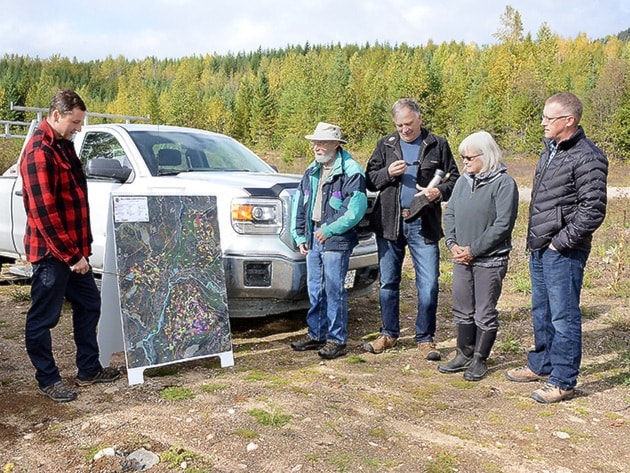Wells Gray Community Forest is planning for the longterm, according to general manager George Brcko.
That was the theme of a tour of the community forest held recently as part of National Forest Week.
Despite the community forest recently announcing that it had up to $1 million available in its new “major grant funding envelope,” and the hundreds of thousands of dollars it has already distributed in grants to local community groups and projects, less than a half-dozen members of the public showed up for the tour.
Wells Gray Community Forest was the first community forest in the province to have sophisticated planning using terrestrial ecosystem mapping (TEM) and vegetative resource inventory (RIM), he said.
Now several other community forests are doing the same.
Now it is using that information to develop a silviculture strategy.
The silviculture strategy uses a forest modelling program that considers multiple land-base objectives and values.
These include forest health management, visual management for scenic corridors, wildlife habitat management, wildfire risk to communities, and hydrological impacts within community watersheds.
The program also considers harvest scheduling and the impacts of silviculture treatments over time.
The computer doesn’t have all the answers, however.
Brcko noted that one recommendation of the program was that an area of mixed deciduous and young conifers near Road 12 northwest of Clearwater should be clearcut and then re-planted to get the optimum return on investment.
“That doesn’t make sense to me,” he said. “There are a lot of good young fir and pine in there. Also, what’s the matter with managing for deciduous?”
Another recommendation from the silviculture strategy program would be to fertilize certain stands a short time before they are harvested.
“I have problems with fertilization if it doesn’t give a lot of growth,” he said. “I don’t know if that’s the solution to our timber supply issue.
Having such a silviculture strategy could allow WGCF to apply for land-base investment funding from the province.
Several other community forests have received the funding, only to have to return it because they did not have adequate plans in place on how to use the money, Brcko said.
Planning for the future is not restricted to computer programs.
For example, quite a few smaller culverts on roads that the community forest inherited when it took over its land-base have been replaced with ones twice the diameter.
New bridges have been installed and stretches of road gravelled.
Quite often problems such as stream flows and sedimentation are not caused by the logging as such but by the roads and ditches, he noted.
An interesting project coming up will be logging around the Candle Creek cross-country ski trails.
The plan is to enhance the skiing experience by providing more gradual ski trails, Brcko said.
